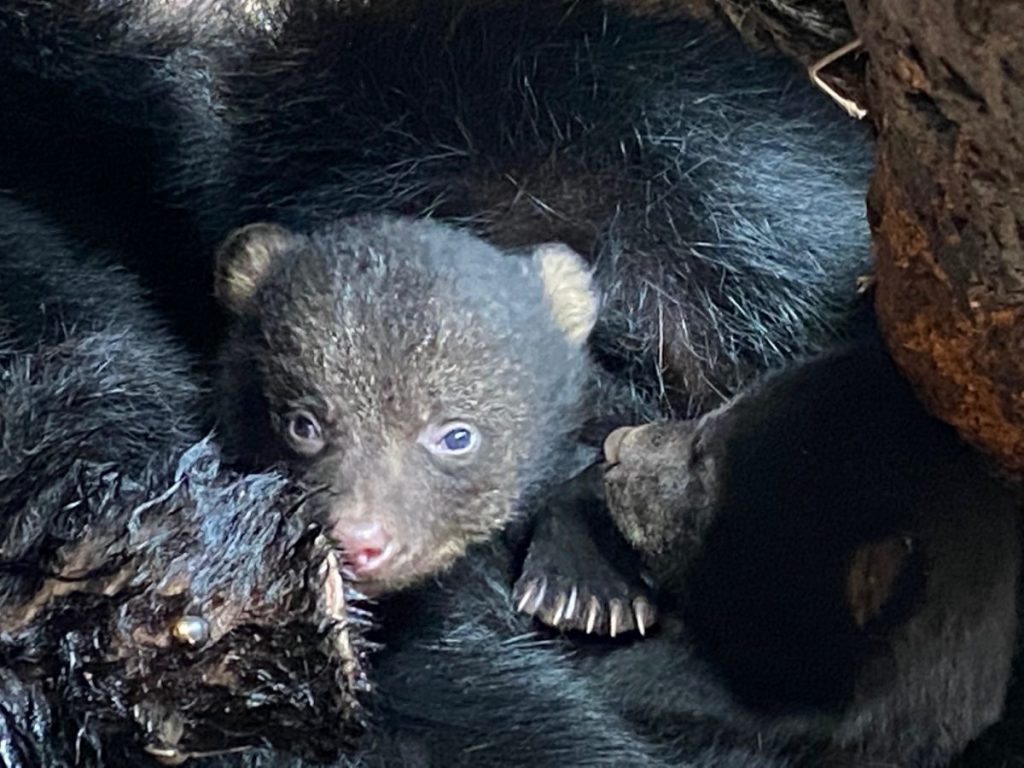by Kate Evans
Black bears start emerging from their dens as early as March and begin causing damage around homes in spring and early summer when there’s little natural food for them to eat. They’re seeking mates and young male bears are leaving the den for new territory. Wildlife officials urge people to not feed the bears or other wildlife.
Emergence
Male bears in West Virginia begin leaving their dens in early to mid-March, said West Virginia Division of Natural Resources (DNR) Wildlife Biologist Colin P. Carpenter, who is the DNR Black Bear Project Leader. Some female bears that have yearlings (cubs born the previous year) will also begin to emerge at this time.
“Females with cubs that were born this year will begin leaving their dens in mid – April to early May. As the family group prepares to begin travelling, the sow will leave the den periodically to get water and then return to the cubs at the den,” Carpenter said in an email.
In southern West Virginia bears will be active periodically throughout the winter. It’s not uncommon to find a bear track anywhere in West Virginia during the winter. However, these bears will lay back down and generally do not stay out all winter, Carpenter said. He doesn’t usually hear about many bears being winter-active in the northern part of West Virginia.
Earlier emergence?
“There is no evidence yet that bears are leaving their dens earlier due to climate change. Bears will stay inactive when there is no food available, so we would have to see significantly earlier green – up in spring to have a meaningful change in den emergence dates,” he added.

This photo of bear cubs in a treetop with the mother bear (sow) was taken by West Virginia Division of Natural Resources (DNR) Wildlife Biologist Colin P. Carpenter. Carpenter is the WV DNR Black Bear Project Leader.
photo by Colin P. Carpenter
Bears are considered “light hibernators” and their type of hibernation is often referred to as torpor. Bears are different from true hibernators in that their body temperature only decreases about 10 degrees and they can awake very rapidly if necessary. They also don’t eat, drink, urinate or defecate while they are in the den. Bears break down stored body fat to provide calories, Carpenter said.
Bear complaints
“Bear complaints can happen during any month, but they usually begin slowly around April 1 and peak in the months of May and June. We often will see a second peak in August when summer berry crops are gone and fall mast crops have not become available,” Carpenter said.
When bears exit their dens in the spring, they are subsisting on green vegetation, insects and carrion until summer foods like serviceberries, blackberries, raspberries and blueberries as they become available.
Carpenter said that females with yearlings (18-month-olds) send the yearlings off on their own in early summer so she can breed again. Breeding takes place during the months of June and July. A lot of young bears will be on their own then for the first time. Adult males travel widely in search of receptive females at this time. These highly active bears will take advantage of easily available food sources.
Bear population
Carpenter estimated that the black bear population in West Virginia is between 12,000 and 14,000. He said the Division of Natural Resources has been actively trying to reduce the growth rate of the bear population in large areas. We “deliberately designed our harvest objectives for the eastern panhandle to keep the bear population at a low level to prevent excessive human – bear conflicts,” he said.
“After more than a decade of liberal hunting seasons in our eastern mountain counties, we have succeeded in reducing our bear population. As a result, I have recommended more conservative hunting seasons in the eastern mountains for 2022,” Carpenter said.
Bear mange
Bear mange continues to be a problem in the Eastern Panhandle and is slowly spreading south through the eastern mountains, he said.
The number of mange cases isn’t high enough to worry about it being a population-decimating factor. They will continue to monitor its spread and work with colleagues in surrounding states to learn more about the impact of mange on black bears, Carpenter said.
Bear break-ins
Bear break-ins to homes and vehicles are rare in West Virginia, Carpenter said. When these incidents occur, “we remove the offending animal from the population to prevent future or escalating bad behavior. In most cases, these types of bear behaviors can be prevented by not allowing bears to have access to human – related foods.”
Carpenter said that in many cases, “bears that are bold enough to break into homes have been human-habituated, food- conditioned, or both. Bears that have lost all fear of humans and learned to associate people with food can become dangerous.”
Since 2008 there have been seven reported bear attacks where contact wasn’t from a hunting situation. None of those attacks were fatal and all but one caused minor injuries to those involved, he said.
Most important
The biggest thing Carpenter wanted to emphasize is “the importance of people removing food attractants from around their homes now. Bird feeders need to be taken down and stored until late fall. Pets that are fed outside should only be given a portion they will finish before dark. Garbage should be stored inside a building or bear – proof container and placed outside on the morning of pickup,” he stressed.
Carpenter said the key to preventing bear problems is to be proactive. Check out more tips to live safely in a bear area.
He advised people to visit the website www.Bearwise.org. This website is designed by the bear biologists of the southeastern United States to provide a cohesive message on how to live with black bears.









